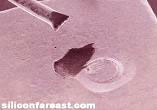Wedge Bond
Heel Breaks
Heel Breaking
is the severing of the wire from its wedge or crescent bond due to a
fracture
in the heel. The
heel
is the portion of the wire where the wire tapers off into the wedge
or crescent bond. It is equivalent to the neck of a ball bond.
Heel break is commonly due to
poor wirebonder set-up.
Poor set-up includes improper bonding parameter settings,
bond head movement settings, and worn-out or contaminated tools.
Incorrect bonding parameters can deform the bond excessively,
resulting in a
very thin
and
weak heel
which can
easily fracture. Improper bond head movements and low loop settings may
subject the wires to
excessive stresses that tend to pull them backward and away from the
bonds, resulting in gross heel cracks which may propagate into total fracture.
Worn-out
and contaminated tools can produce mechanical damage or defects in the wires which can act as
starting points for crack propagation.
|
 |
|
Figure 1.
A Heel Break
|
Heel breaks
have also been traced to
mechanical
stresses applied
to the package. In hermetic packages, for instance, the high-frequency
vibrations produced by ultrasonic cleaning or sandblasting tend to subject the wires to violent
vibratory stresses that can
easily propagate heel cracks to fracture. Thermo-mechanically
induced delaminations in the lead finger areas of plastic packages also
result in second bond heel cracks.
Corrosion,
which can significantly reduce the diameter of a bond wire, can also
lead to heel breaks. It is often
due to the presence of corrosive contaminants
such as Cl and S
in the wires and bonds.
Heel breaking
may be
accelerated
by SHRT,
Temp Cycle, and Thermal Shock.
See also:
Neck Breaks;
Package
Failure Mechanisms; Wirebonding; Failure Analysis
HOME
Copyright
©
2005.
EESemi.com.
All Rights Reserved.

